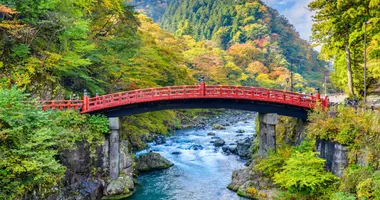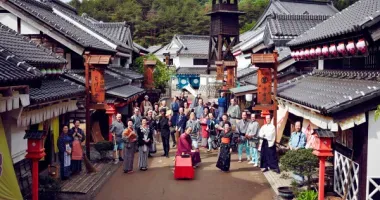Kirifuri Highland & Kawaji Onsen
Japan City Guides: Kirifuri Highland and Kawaji Onsen 霧降高原 川治温泉 & Nikko, Tochigi Prefecture 日光 栃木県
Johannes Schonherr
Besides all the grand temples, shrines and historical sites Nikko has to offer, the town is also a great base to explore some truly amazing natural scenery. Turn west and you will arrive at Lake Chuzenji and the Kegon Falls. Go straight north and you will soon climb a lonely road leading up to the Kirifuri Highland in Tochigi Prefecture.
That road would be Highway 169. Its hairpin curves take you up to the Roppozawa Bridge crossing a wide valley at an elevation of 1433m. The bridge itself is 290m above the ground of the valley and it offers gorgeous views towards the lower mountain ranges on one side and towards the forbidding peaks on the other.

Highway 169 to Kirifuri Highland, Tochigi Prefecture.
If it offers much of a view at all, that is. Kirifuri translates to "fog falling" and the area isn't named like that without a reason. Clouds and fog tend to gather up there.
A few curves further up the road you find a large scenic parking area complete with a national park guard station. From there, various hiking trails lead into the woods and up to the surrounding mountain tops. They are crowded with visitors during the colorful and usually sunny autumn color season but hauntingly quiet and lonesome when the Kirifuri is blanketed by its trademark fog.
If you like classic Japanese paintings depicting fog in the mountains and if you want to experience the feeling they express first-hand, Kirifuri might be a good place to visit.

Roppozawa Bridge, Kirifuri Highland, Tochigi.
Ozasa Ranch
Driving on you will pass by Ozasa Ranch. As quiet as the mountains may have been, the farm is bustling with tourists. In fact, it's rather a crowded shopping and restaurant center with cows and sheep feeding on the pastures outside. A shopping center strictly for local agricultural products, though. Well worth a stroll through the aisles. Kirifuri produces great cheese and meat in many variations; on the tables in the large restaurant you can roast local beef right at the table yakiniku-style.
It feels slightly mysterious, though how all those many customers got to the farm since you will hardly encounter a tourist bus or any other car for that matter when you drive on, now downwards to the upper reaches of the Kinugawa River. The villages along the way are small, remote and very picturesque.
Highway 169 ends once it hits the Kinugawa. Turn right onto Highway 23 towards Kawaji Onsen.
Kinugawa means "Angry Devil River". It looks lovely winding through the valley alongside the cherry trees … but at some point in the past it has certainly earned its grim name.

Kirifuri Highland, Tochigi Prefecture.

Kawaji Onsen main street, Tochigi.
Kawaji Onsen
In Kawaji Onsen town, the Kinugawa and the Ojikagawa Rivers merge, continuing on as a slightly wider Kinugawa River towards Kinugawa Onsen further downstream.
Kawaji Onsen is a tranquil little hot spring town. It has numerous hotels and inns and a train station connecting it via Kinugawa Onsen with Tokyo but visitors from far-flung places don't have much of a presence. The feeling of the town is decidedly local.
The perhaps best place to connect to that local feeling might be a visit to the Asahiya Soba noodle restaurant in the center of the town. The sign outside the restaurant announces its specialty in much bigger letters than its actual name: Te uchi soba (手打そば) it says, translating to "Hand-made Soba".
Rice can't be grown up here in the mountains, so the main crop is buckwheat. From buckwheat, soba noodles are made and the Kawaji area is famous for its soba, prepared the old-style hand-made way.
Enter the Asahiya, order your bowl of steaming hot soba and take in the scenery. Here, the old men of the town congregate, slurping noodles or chewing on not so local fried shrimp. Already at lunchtime, they gulp their well-filled glasses of shochu while discussing local affairs. You might just feel like leaning back and have a glass yourself after finishing that delicious bowl of soba.

Hand-made Soba noodle restaurant Asahiya in Kawaji Onsen
Manju
A few houses down the street is a little manju store offering the perfect dessert. Manju are a kind of Japanese sweet, little balls made of wheat and rice and filled with azuki red bean paste, usually steamed with hot spring steam. The typical old-style one-man stores selling them fresh and hand-made by the owner you can find in most traditional hot spring towns - but hardly anywhere else.
A hot spring town Kawaji Onsen certainly is. Pack a towel and head down to the river. Alongside the river, you will find plenty of hot spring baths. They are partly open-air and you can enjoy a look at the river and the steep hills right behind it while soaking in the hot water.
You might just feel like booking straight into one of the many traditional inns and stay a day longer.
The road up north towards Minamiaizu is called Soba Kaido (Soba main road) and in every old, small and scenic village along it, you will see flags and signs announcing yet another soba noodle restaurant. All of them certainly make their noodles by hand and they all look like being definitely worth a try - but then, how much soba can you possibly eat? One bowl already fills the stomach.
For a good rounding out of a first visit Kirifuri tour, it may be a good idea to turn right onto Highway 400 towards Shiobara town once that intersection comes up and then to turn onto the Nikko Shiobara Momiji Line toll road shortly before reaching Shiobara.

Roppozawa Bridge, Kirifuri Highland, Tochigi.
That road, though coming with a hefty 700 Yen toll per car, offers great viewpoints and it leads you right back south towards Nikko city via Kinugawa Onsen town.

Hot spring baths by the river in Kawaji Onsen

View from Kirifuri Toll Road, Tochigi, Japan
Hotel Accommodation in Nikko
Nikko has hotel accommodation to suit all budgets. Some recommended places to stay in Nikko include the Nikko Station Hotel Classic right at Nikko Station with an indoor hot spring bath and terrace, the Japanese-style Nikko Tokanso with tatami rooms and for budget travelers the Nikkorisou Backpackers.
At Lake Chuzenji and Kegon Falls choose from the Hotel Kohantei, the Yama-no-Yado Sugimoto-kan, the Hotel Shikisai and the Nikko Lakeside Hotel.
Kinugawa Onsen Access
Train
Kinugawa Onsen might be a good alternative as a starting point. By train, you can go there in about two hours from Tokyo via Omiya in Saitama by shinkansen and then change to the Limited Express to Kinugawa Onsen. Alternatively there are direct Tobu Line Spacia express trains from Shinjuku Station, Asakusa and Kita-Senju (107 minutes).
Getting to Kawaji Onsen by train from Tokyo requires a number of changes and takes about 2 hours and 40 minutes. The best route is to take the Tobu Line Spacia to Kinugawa Onsen and then change to the Tobu Kinugawa Line to Shin-Fujiwara and then change to the Yagan Tetsudo Railway for the 7 minute journey to Kawaji Onsen.
Traveling around Kirifuri, it is best to have your own means of transport: a car, a motorbike or if you truly like to go up long stretches of steep mountains by the power of your own legs, a bicycle.
Ozasa Ranch: open daily, Tel: 0288 97 1116 (in Japanese), website: www.nikko-ozasa.jp (in Japanese)
Asahiya Soba Restaurant in Kawaji Onsen: open daily from 11am to 5pm, closed on 4 irregular days per month, Tel 0288 78 0109 (in Japanese)
Nikko Access
From Tokyo, Nikko is accessible via the Tobu-Nikko Line (aka Tobu Skytree Line) from Asakusa station. The tokkyu (Limited Express train) takes 1 hour 50 mins, and the kaisoku (Rapid) takes 2 hours.
IMPORTANT: Check beforehand with the station staff whether or not you need to change trains at Imaichi. Asking this question could save you hours.
To ask in Japanese: Imaichi (EE-MY-CHEE) de norikae no hitsuyo ga arimaska? or, better still, go here to print the question out in Japanese (as an image file, so doesn't require Japanese font capability) and simply show the printed question to the station staff.
For JR Rail Pass holders, an alternative route is by shinkansen (bullet train) to Utsunomiya (50 mins) and then a local JR train to Nikko (45 mins).
Nikko-Kinugawa Pass
Available from Tokyo Asakasa station - this 2-day pass includes train travel (though not the Express surcharge) to Nikko, bus travel between Nikko, Chuzenji Lake, Kinugawa onsen and Yumoto onsen, as well as boats and cable cars in these areas.
Access to Nikko from Nikko Station
From the Tobu line Nikko station to the Nikko temple and shrines (known as the "Nikko San'nai" area), it is a 5-minute bus or taxi ride, or a 20-minute walk. The bus station is right in front of the train station, and the road up to Nikko San'nai is the road visible beyond the bus station.

View from Kirifuri Toll Road, Tochigi, Japan
Book Hotel Accommodation in Nikko Japan
Books on Tokyo Japan
Kirifuri Highland and Kawaji Onsen: read a guide to the remote Kirifuri Highland area of Tochigi Prefecture and Kawaji and Kinugawa Onsens.
















